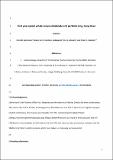Files in this item
First-year sperm whale calves echolocate and perform long, deep dives
Item metadata
| dc.contributor.author | Tønnesen, Pernille | |
| dc.contributor.author | Gero, Shane | |
| dc.contributor.author | Ladegaard, Michael | |
| dc.contributor.author | Johnson, Mark | |
| dc.contributor.author | Madsen, Peter T. | |
| dc.date.accessioned | 2019-09-20T23:38:39Z | |
| dc.date.available | 2019-09-20T23:38:39Z | |
| dc.date.issued | 2018-10 | |
| dc.identifier | 256198854 | |
| dc.identifier | 0c50b2f8-3820-4e6b-b519-e584ce9eb627 | |
| dc.identifier | 85053819748 | |
| dc.identifier | 000445192700007 | |
| dc.identifier.citation | Tønnesen , P , Gero , S , Ladegaard , M , Johnson , M & Madsen , P T 2018 , ' First-year sperm whale calves echolocate and perform long, deep dives ' , Behavioral Ecology and Sociobiology , vol. 72 , 165 . https://doi.org/10.1007/s00265-018-2570-y | en |
| dc.identifier.issn | 0340-5443 | |
| dc.identifier.uri | https://hdl.handle.net/10023/18532 | |
| dc.description | Funding: Field research was supported by an FNU large frame grant and a Villum grant to PTM and by a Carlsberg Foundation expedition grant and an FNU fellowship from the Danish Council for Independent Research supplemented by a Sapere Aude Research Talent Award to SG. PT supplemented funding through support from the Oticon Foundation, the Augustinus Foundation, the Danish Tennis Foundation, and the Danish Acoustical Society Foundation. | en |
| dc.description.abstract | Deep-diving sperm whales have a complex social structure and the largest brain of any animal, but very little is known about the ontogeny of their diving, foraging, echolocation, and communication skills. In large-brained terrestrial species, social skills develop earlier than locomotor abilities, but this may not be feasible for sperm whales, which require locomotor skills from birth to breathe, swim, and suckle. Here, we shed new light on the relative development of social and locomotor capabilities of a wild toothed whale. Sound and movement recording tags deployed on three first-year sperm whale calves for a total of 15 h revealed that these calves rarely produced codas for communication with adult whales, but likely tracked the ample passive acoustic cues emitted by clicking adults. The calves’ diving capabilities were well developed (maximum dive depth: 285, 337, and 662 m; maximum dive time: 11, 31, and 44 min) and they all produced clicks in a way that is consistent with echolocation. The calf performing the longest and deepest dives additionally emitted two echolocation buzzes, suggesting that it could have attempted to forage. Thus, sperm whale calves may supplement their milk diet with food caught independently at depth much earlier than previously believed. Contrary to terrestrial mammals, we propose that the maturation of locomotor, diving, and echolocation skills may be favored over investment in developing social communication skills at an early age in sperm whales. | |
| dc.format.extent | 824280 | |
| dc.language.iso | eng | |
| dc.relation.ispartof | Behavioral Ecology and Sociobiology | en |
| dc.subject | Behavior | en |
| dc.subject | Coda | en |
| dc.subject | Dive capability | en |
| dc.subject | Echolocation | en |
| dc.subject | Ontogeny | en |
| dc.subject | Sperm whale | en |
| dc.subject | QH301 Biology | en |
| dc.subject | Ecology, Evolution, Behavior and Systematics | en |
| dc.subject | Animal Science and Zoology | en |
| dc.subject | NDAS | en |
| dc.subject.lcc | QH301 | en |
| dc.title | First-year sperm whale calves echolocate and perform long, deep dives | en |
| dc.type | Journal article | en |
| dc.contributor.institution | University of St Andrews. Sea Mammal Research Unit | en |
| dc.contributor.institution | University of St Andrews. School of Biology | en |
| dc.contributor.institution | University of St Andrews. Scottish Oceans Institute | en |
| dc.contributor.institution | University of St Andrews. Marine Alliance for Science & Technology Scotland | en |
| dc.contributor.institution | University of St Andrews. Sound Tags Group | en |
| dc.contributor.institution | University of St Andrews. Bioacoustics group | en |
| dc.identifier.doi | https://doi.org/10.1007/s00265-018-2570-y | |
| dc.description.status | Peer reviewed | en |
| dc.date.embargoedUntil | 2019-09-21 |
This item appears in the following Collection(s)
Items in the St Andrews Research Repository are protected by copyright, with all rights reserved, unless otherwise indicated.

